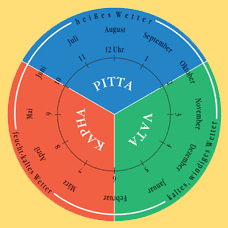
According to the concept of Ayurveda, the human body is made up of five elements (panchamahabhootas), seven tissues (dhatus), waster products (malas), channels (srotas) and energy modes (doshas).
Every living and non-living thing in the universe is a combination of five basic elements. The seven dhatus or tissues are responsible for composing the human body. Malas are the body wastes and proper elimination of the waste products is an important factor in maintaining good health. Srotas are the channels that transport the nutrients and other substances to all parts of the body. The three doshas (tridoshas) are responsible for the creation of various tissues of the body and to eliminate the waste products from the body. All the bodily movements and other physiological functions are influenced by the tridoshas.
The word tridoshas is composed of two parts- tri and doshas, tri means three and doshas means the physical modes or energies. These tridoshas are the primary and essential factors of the human body that controls the physical structure and all the functions of the body. These doshas are derived from the five basic elements known as the panchamahabhootas. Each dosha is the combination of any two of the five elements with one primary and the other secondary. The three doshas are responsible for the physiological and psychological processes taking place in the mind and body.
All activities in the universe are categorized into three main basic functions- creation, organization and destruction. The balance state of these functions is a key to good health.
According to Ayurveda these three functions are balanced by tridoshas namely vata (wind), pitta (bile) and kapha (mucus).
The main cause of disease is the lack of proper physiological and psychological functions that is due to an excess or deficiency of vata, pitta and kapha.
Vata is composed of elements air and space. This biological humor is responsible for controlling the function of destruction. It is regarded as the main dosha among all the three as it controls and governs all the functions performed by other doshas.
Pitta is composed of elements fire and water. It organizes all activities performed by body after the process of transformation. The whole chemical process including enzymes, immune power, hormones, nerves and the nutritional system attributes to pitta. Kapha is composed of elements earth and water. It is responsible for the maintenance of all creations taking place in the body. All the activities of the skeletal and the anabolic system come under kapha.
According to Ayurveda’s basic concept of human body there are seven body types and they are :
Mono Types
o Wind dominated individuals (vata)
o Bile dominated individuals (pitta)
o Mucus dominated individuals (kapha)
Dual Types
Wind and bile dominated individual (vata and pitta)
Wind and mucus dominated individuals (vata and kapha)
Bile and mucus dominated individuals (pitta and kapha)
Equal Types
Vata, pitta and kapha in equal proportions
